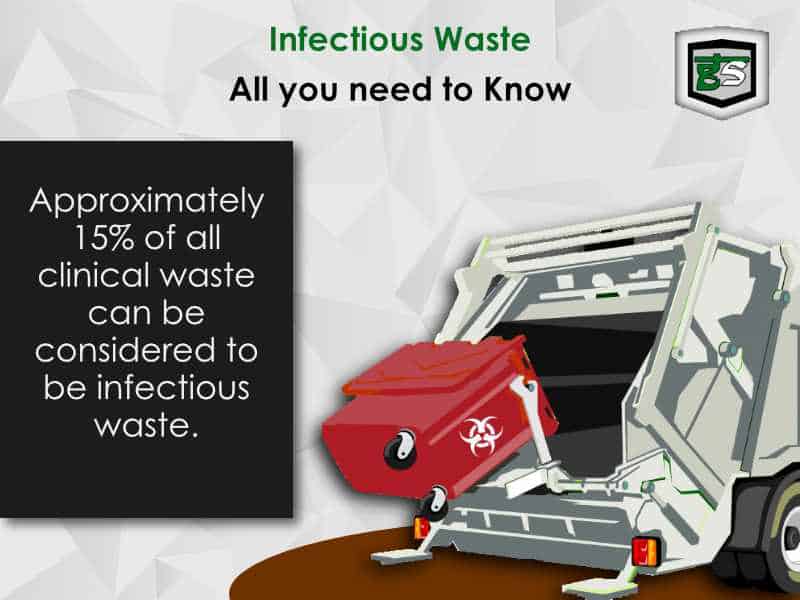Approximately 15% of all clinical waste can be considered to be infectious waste.

Infectious waste can be referred to as waste that may cause spread of infections or infectious agents. This waste may include some or all of the following:
- Waste that is contaminated with blood or other bodily fluids.
- Waste samples, cultures and or stocks from pathology and other laboratories.
- Waste from patients in isolation wards.
- Discarded masks, suits and other equipment used by doctors, nurses and or attendants while treating or attending to infected patients.
Infectious waste can be considered as a sub-category of Hazardous Waste and or Bio-medical Waste.
Generation of Infectious Waste
Infectious wastes are generated due to several reasons and at several different facilities.
Infectious waste is generated on a regular basis at most of the facilities conducting their daily routines like hospitals, clinics and other medical centers.
Additionally, infectious waste can also be generated at more facilities due to pandemics and epidemics. During such times, proper management and disposal of infectious waste plays a key role in containing, managing, controlling and eradicating such events.
Some facilities where infectious waste may be generated:
- Pathology Labs
- Doctors’ Clinic
- Dentists’ Clinic
- Nursing Homes
- Mortuaries
- Veterinary Facilities
- Forensic Facilities
- Hospitals
- Other Medical Centers
Some quantities of infectious waste is also generated while the storage of infectious waste since while handling of this waste, adequate protective gear has to be used. Small quantities of infectious wastes can also generate from offices, schools, colleges, eateries and or residential set ups.
The management of infectious waste is costlier and more complex compared to standard solid waste management.
Types of Infectious Waste
For the proper disposal of infectious waste, identifying the type of infectious waste is imperative. Some of the most common types of Infectious wastes are mentioned below:
- Blood and Blood Products – These may also include plasma, serum, other bodily fluids.
- Pathological Waste – These may include tissues, implants and or body parts that may be extracted during a procedure or an autopsy of a human or an animal.
- Solid Waste – These may include Tubing material from IV equipment, surgical gloves and masks, Personal Protective Equipments (PPE), wound dressings, and other equipments that may be used in the physical treatment of humans and animals.
- Sharps – These may include needles, scalpels, blades, broken vials or any sharp item that can be used to draw blood, tissue samples or perform a procedure on a human or an animal.
- Laboratory Waste – These may include cultures or stocks or agents that can be collected, analysed and processed to identify diseases, ailments, etc.
- Regulated Human Body Fluids – These may include amniotic fluid, cerebrospinal fluid, pleural fluid, pericardial fluid, etc
- Animal Waste from Research – These may include animal body parts, carcasses etc that could have been involved in scientific or medical research.
- Chemotherapy Waste – This may include drugs, sheets, pads, containers, IV bags, containers and more that can be used to provide different types of chemotherapies having the potential to be infectious.
- Others – These may include any material that could be contaminated with or may have been exposed to communicable diseases. These may generate at any place.

Handling of Infectious Waste
Since infectious wastes bear with them high risks, extreme care and caution needs to taken while handling them. Properly trained individuals and staff members who are aware about the segregation and storage protocols should be the only ones to handle infectious waste.
The following steps are followed as a whole in the overall handling process of infectious waste.
Step 1
Identification
Step 2
Segregation
Step 3
Packaging
Step 4
Storage
Step 5
Transport
Step 6
Disposal
Storage of Infectious Waste
It may not be possible to immediately treat and dispose all infectious waste as and when it is generated. Therefore, it is important to store this infectious waste in appropriate manner so that it does not end up contaminating other items as well.
Depending on the type of Infectious Waste, different storage protocols may be implemented.
Almost all types of infectious waste should be stored in red containers, bins or storage devices which are adequately marked and have very limited or restricted access.
Most types of infectious waste should be stored in red plastic bags or containers that are impervious to moisture and are tear resistant.
Infectious wastes like sharps, pathological waste, parts of laboratory wastes should be stored in leak proof, puncture resistant, rigid red containers that can be sealed using lids or tapes.
The duration for which infectious wastes should be stored depends on the type and quantity of waste being generated. Generally, it is preferred that all infectious waste be stored for :
- Not more than 48 Hours for waste that includes body parts, carcasses etc
- Not more than 7 Days for waste items and materials
- Not more than 30 Days if refrigerated or frozen for waste items and materials
Disposal of Infectious Waste
Selecting the best disposal method for infectious waste heavily depends on the quantity and type of infectious waste.
In general, there are three methods of disposal of infectious waste.
- Autoclaving or Sterilization – A method that uses high pressure steam to sterilize and neutralize the infectious agents on waste items.
- Incineration – A method where infectious waste is completely incinerated. May be incinerated in a waste to energy set up also.
- Dumping at Landfills (least preferred method ) – A method where, infectious waste having undergone basic treatment is dumped at a pre-approved landfill site.

